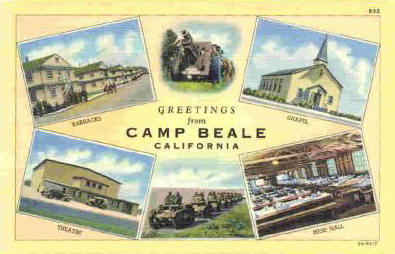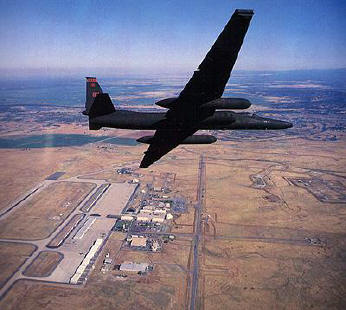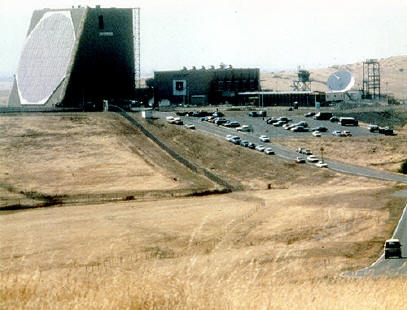| SAC Bases: Beale
Air Force Base |
|
|

|
Beale is home of the 9th Reconnaissance
Wing, and is also considered by many to be one of the show places of the United
States Air Force. A base steeped in history, it is in the forefront of the Air
Force’s future in high technology. Beale is located in northern California about
10 miles east of the towns of Marysville and Yuba City and about 40 miles north
of Sacramento, the state capital. Beale is a large base in terms of land and has
five gates providing access on all sides of the base. Visitors enter the base
through a main gate that local merchants, individuals and the Beale Military
Liaison Committee donated $100,000 to construct. The base, covering nearly
23,000 acres, is home for approximately 4,000 military personnel.
Unlike most Air Force bases, which since the birth of the Air Force in
September 1947 have carried the name of famous aviators, Beale AFB honors the
man who founded the Army Camel corps and who was one of California's largest
landholders. Camp Beale opened in October 1942 as a training site for the 13th
Armored and the 81st and 96th Infantry Divisions. During World War II, Camp
Beale’s 86,000 acres were home for more than 60,000 soldiers, a prisoner-of-war
encampment and a 1000-bed hospital. In 1948, the camp transferred from the Army
to the Air Force.
The Air Force conducted bombardier and navigator training at Beale and, in
1951, reactivated the Beale Bombing and Gunnery Range for aviation engineer
training. The base has been under several commands including: Air Training
Command, Continental Air Command, Aviation Engineer Force, Strategic Air Command
and, on June 1, 1992, the newly created Air Combat Command. The U-2 began flying for the Air Force in 1956.
In May 1959, Colonel Paul K. Carlton assumed command of the recently
activated 4126th Strategic Wing. The first two KC-135s arrived two months later
on July 7, 1959. On Jan. 18, 1960, the 31st Bombardment Squadron with its B-52s
arrived at Beale to become part of the wing. The 14th Air Division moved to
Beale from Travis Air Force Base one week later. On Feb. 1, 1963, SAC
redesignated the 4126th as the 456th Strategic Aerospace Wing. On Sept. 30,
1975, the 456th Bombardment Wing inactivated, and the 17th Bombardment Wing
activated in its place. On Sept. 30, 1976, the 17th inactivated, and the 100th
Strategic Reconnaissance Wing at Davis-Monthan Air Force Base, Ariz., became the
100th Air Refueling Wing and moved to Beale. Many of the people and the tankers
that had been part of the 17th now became members of the 100th. The 17th Wing’s
B-52s moved to other bases. The 100th ARW stayed at Beale until March 15, 1983,
when the Air Force inactivated the wing and consolidated its refueling mission
and assets into the 9th Strategic Reconnaissance Wing.
From 1959 until 1965, Beale was support base for three Titan I missile sites
near Lincoln, Chico and the Sutter Buttes.
On July 1, 1979, the 7th Missile Warning Squadron brought the PAVE PAWS radar
site to Beale. This 10-story structure can detect possible attack by
sea-launched ballistic missiles. The 7th Missile Warning Squadron operates a
PAVE PAWS phased array radar situated on the outskirts of Beale AFB in south
central California. The radar is primarily used to detect submarine launched
ballistic missiles. Mock missile attacks, site emergencies and equipment
failures keep the Canadian and American crew busy. A routine training session
can become a lesson in the unexpected. When the Beale radar picks up a
disintegrating spacecraft, usually there's a warning. Once or twice a year, when
the system is being used for training, it goes to an operational display over
the Pacific, tracking a satellite which is breaking up with pieces all over the
place. Following appropriate procedures, the crew runs tests to ensure the
pieces are from the same object, providing no-notice training.
On Oct. 15, 1964, the Department of Defense announced that Beale would be the
home of the new, supersonic reconnaissance aircraft, the SR-71 Blackbird. The
4200th Strategic Reconnaissance Wing activated on Jan. 1, 1965. The new wing
received its first aircraft, a T-38 Talon, on July 8, 1965. The first SR-71 did
not arrive until Jan. 7, 1966. On June 25, the 9th Strategic Reconnaissance
Wing, that began as the 9th Observation Group in 1922, and its 1st Strategic
Reconnaissance Squadron activated as the 1st Aero Squadron in 1913, replaced the
4200th. The first U-2 arrived from Davis-Monthan on July 12, 1976. Until Jan.
26, 1990, when budget restrictions forced the retirement of the SR-71, Beale was
the home of two of the world’s most unique aircraft.
On Sept. 1, 1991, the 14th Air Division inactivated, and the 2nd Air Force,
with a lineage stretching back to World War II, activated at Beale. Second Air
Force inactivated on July 1, 1993, and activated at Keesler Air Force Base,
Miss., that same day. In July 1994, the 350th Air Refueling Squadron transferred
from Beale to McConnell Air Force Base, Kan., taking the last of the KC-135Q
tankers with it.
Also, in 1994, Congress directed the reactivation of three SR-71s and their
return to operational status by Sept. 1, 1995. The aircraft were maintained at
Beale’s Detachment 2 at Edwards Air Force Base, Calif. |
 |
 |
|
U-2 over Beale AFB |
7th Space
Warning Station |
|
|
